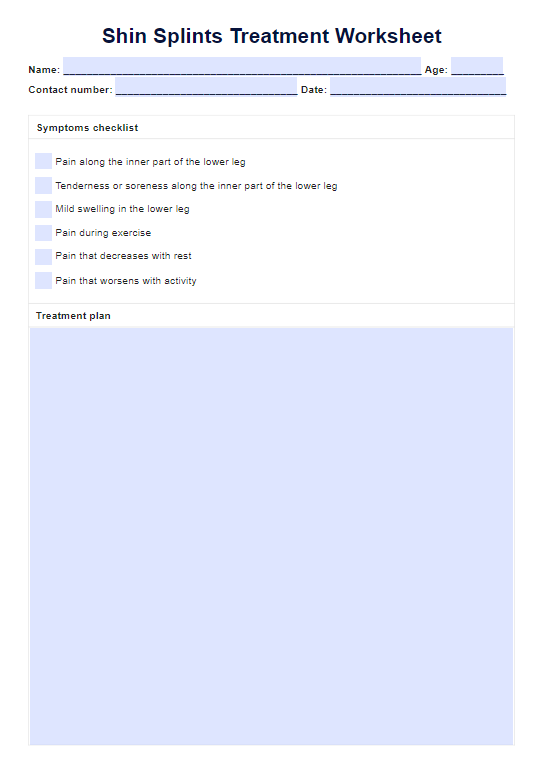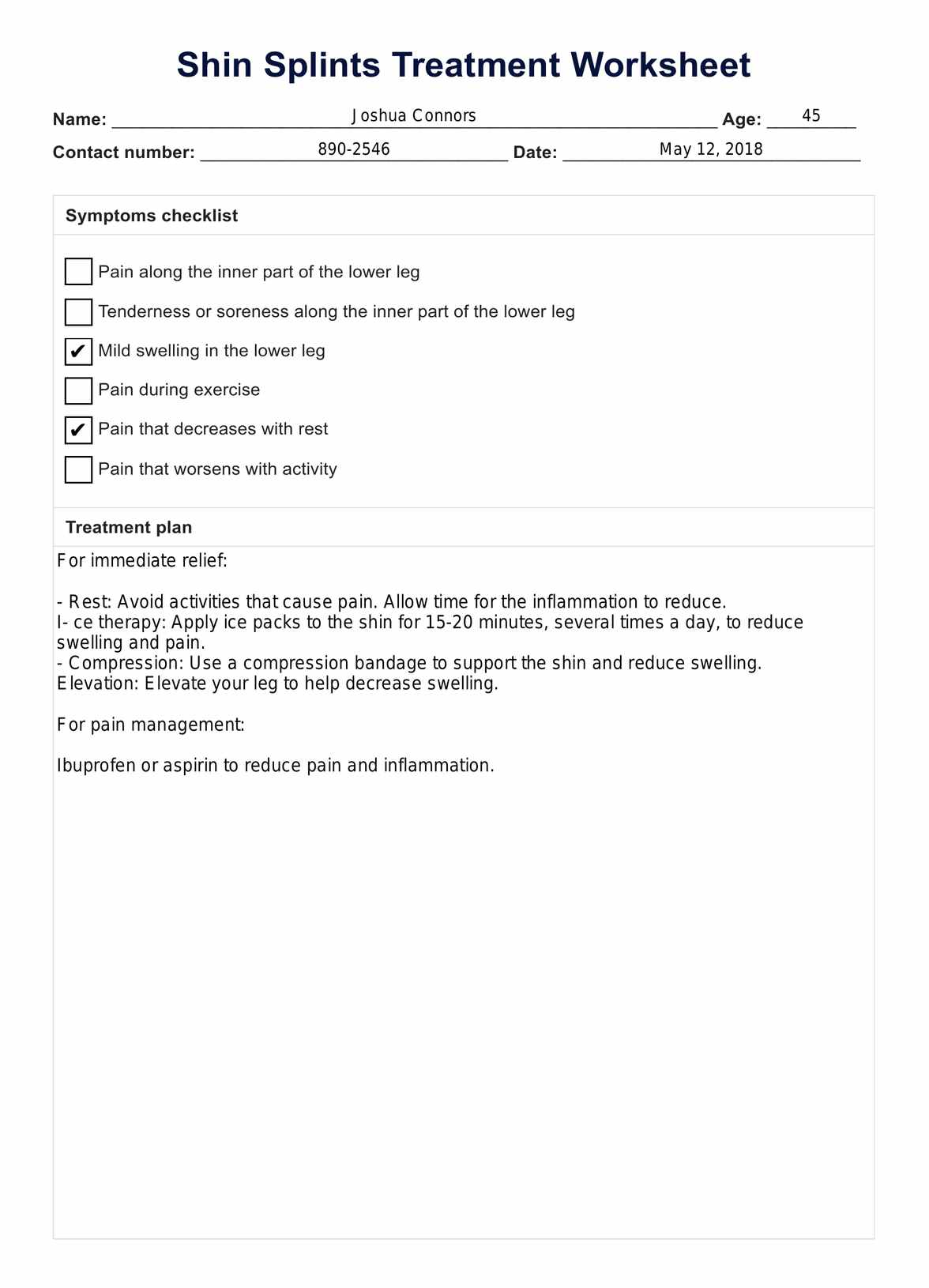Shin Splints Treatment Worksheet
The Shin Splints Treatment Worksheet provides medical practitioners with practical strategies, including rest, ice, anti-inflammatory meds, exercises, and prevention tips.


What is the medial tibial stress syndrome?
Medial tibial stress syndrome (MTSS), commonly known as shin splints, is a common injury that affects the muscles and bones of the lower leg. It is caused by repetitive stress and overuse, usually from activities such as running, jumping, or dancing.
Shin splints symptoms
The one of the main symptoms of shin splints of is pain along the inner edge of the shin bone (tibia). The pain may be dull or sharp and may worsen during physical activity. Other symptoms include:
- Tenderness to touch on the inner side of the shin
- Swelling in the lower leg
- Weakness in the ankles or feet
- Numbness or tingling in the feet
Causes of shin splints
MTSS is caused by overuse and stress on the muscles, tendons, and bones of the lower leg. Some factors that may contribute to the development of MTSS include:
- Increasing physical activity level too quickly or abruptly
- Poor footwear or improper training techniques
- Flat feet or high arches
- Muscle imbalances in the legs
Shin Splints Treatment Worksheet Template
Shin Splints Treatment Worksheet Example
How do nurses diagnose shin splints?
Nurses play a crucial role in diagnosing shin splints by thoroughly assessing the patient's symptoms and physical activity. Here's how nursing diagnosis of shin splints typically goes:
- The nurse gathers details about the patient's shin pain, including onset, duration, and nature. They ask about changes in exercise routine, high-impact activities, recent fitness changes, history of lower leg injuries, and type of footwear used to ensure proper support.
- Nurses then inspect the lower legs for swelling, redness, or other abnormalities. They gently palpate the shin bones (tibia) to identify areas of tenderness or pain. Tenderness along the inner edge of the shinbone is a key indicator of shin splints. Assess the range of motion in the ankle and foot to check for any restrictions or pain during movement.
- They document the exact location of the pain (inner or outer shin) and its severity (mild, moderate, severe). Also, nurses note if the pain occurs during, after, or persists beyond exercise.
- Nurses often ask the patient to perform specific movements or exercises to see if the pain increases with activity. Observing the walking or running technique to reveal any biomechanical issues, such as overpronation.
- Finally, nurses differentiate shin splints from more serious conditions like stress fractures, which typically cause localized pain and may require imaging for confirmation. They assess for signs of compartment syndrome, a condition that causes severe pain and requires immediate medical attention.
Treatment options for shin splints
Treatment for shin splints typically involves a combination of rest, ice, anti-inflammatory medication, exercises, and prevention strategies.
- Rest: Individuals with MTSS should rest from physical activities that aggravate their symptoms. This allows the injured tissues to heal and reduces further stress on the legs.
- Ice: Applying ice to the affected area can help reduce pain and swelling. It is recommended to apply ice for 15-20 minutes, several times a day to treat shin splints.
- Anti-inflammatory medication: Over-the-counter nonsteroidal anti-inflammatory drugs (NSAIDs), such as ibuprofen or naproxen, can help reduce pain and inflammation associated with MTSS. However, patients should always consult with their doctor before taking any medication.
- Exercises: Stretching and strengthening exercises can help improve muscle imbalances, increase flexibility, and reduce the risk of future MTSS. A physical therapist can recommend specific exercises based on individual needs.
How to prevent shin splints
To prevent shin splints, it is important for individuals to have a structured exercise plan and to listen to their body. Here are some steps patients can follow to prevent this common injury:
- Wear proper footwear: Wearing appropriate shoes that provide good support and cushioning can help prevent shin splints. Individuals should avoid over-worn shoes that lack proper shock absorption.
- Avoid sudden increases in exercise intensity: Gradually increasing the intensity and duration of workouts can help prevent shin splints. Sudden increases in activity can put added stress on the muscles and lead to injury.
- Incorporate strength training: Strengthening the muscles in the lower legs, calves, and hips can help prevent shin splints. Exercises such as calf raises, squats, and lateral lunges can improve muscle strength and stability.
- Stretch before and after exercise: It is important for individuals to properly warm up before exercising and cool down afterwards. Stretching helps improve flexibility and decreases the risk of injury.
- Cross-train: Participating in a variety of activities, such as cycling or swimming, can reduce the impact on the lower legs and help prevent shin splints.
- Listen to your body: If individuals experience pain or discomfort while exercising, it is important for them to stop and rest. Pushing through the pain can worsen shin splints and lead to other injuries.
In addition to these preventative measures, patients should also pay attention to any changes in their training routine or equipment that may be contributing to shin splint development. It is also important for individuals with flat feet or high arches to wear proper orthotic inserts to provide additional support and stability while exercising. These inserts can also help correct any biomechanical imbalances that may be contributing to the development of shin splints.
Furthermore, it is important for individuals to maintain a healthy overall lifestyle by staying hydrated, getting enough rest, and eating a balanced diet. This will not only improve physical fitness but also aid in injury prevention.
Commonly asked questions
Rest, ice, and over-the-counter pain relievers are effective treatments for shin splints. Additionally, shoe inserts can support and reduce stress on bone tissue around the shin bones.
To quickly alleviate the dull pain of shin splints, rest from high-impact activities, apply a cold pack to the affected area, and use compression. Incorporate gentle stretching exercises and cross-train with low-impact sports like swimming or cycling. However, if individuals experience any exercise pain during workout routines, they should consult their doctor immediately.
A stress fracture is a small crack in the bone often caused by overuse and repetitive activities. It is sometimes confused with shin splints, as both conditions can cause pain in the lower leg. Unlike shin splints, which affect muscle and tendon tissues, a stress fracture specifically involves the bone.







































































































